|
|
|
|
|
|
|
|
|
|
|
|
|
|
|
|
|

|
| Image via http://en.wikipedia.org/wiki/Yoseft... |
| Yoseftal Medical Center |
Yoseftal Medical Center (Hebrew: הַמֶּרְכָּז הָרְפוּאִי יוֹסֵפְטַל) is a hospital inEilat, Israel.
Yoseftal Hospital, founded in 1968, is the southernmost hospital in Israel and the only hospital covering the southern Negev desert. It is named afterGiora Yoseftal. It is Israel's smallest general hospital with 65 beds. Economic problems led to proposals for the hospital's closure; however, after protests from area residents and local government officials, who argued that not having a hospital within a 3-hour radius would be highly dangerous, it was decided to keep the hospital open.
The hospital is run by the Clalit health maintenance organization. It has a fully equipped recompression chamber for treating diving accidents. The hospital also has kidney dialysis facilities open to vacationers and local residents. more from Wikipedia |
|
|
|
|
|
|
|
|
|
|
|
|
|
|
|
|
|
|
|
|
|
|
|
|

|
| Image via http://en.wikipedia.org/wiki/Archae... |
| Archaeological sites in Israel |
The archaeology of Israel is the study of the archaeology of the present-day Israel, stretching from prehistory through three millennia of documented history. The ancient Land of Israel was a geographical bridge between the political and cultural centers of Mesopotamia and Egypt. Despite the importance of the country to three major religions, serious archaeological research only began in the 15th century. The first major work on the antiquities of Israel was Adrian Reland's Palestina ex monumentis veteribus, published in 1709. Edward Robinson, an American theologian who visited the country in 1838, published the first topographical studies. A Frenchman, Louis Felicien de Saucy, embarked on the first "modern" excavations in 1850.
In discussing the state of archaeology in Israel in his time, David Ussishkincommented in the 1980s that the designation "Israeli archeology" no longer represents a single uniform methodological approach; rather, its scope covers numerous different archaeological schools, disciplines, concepts, and methods currently in existence in Israel. more from Wikipedia
|
|
|
|
|
|
|
|
|
|
|
|
|

|
| Image via http://en.wikipedia.org/wiki/Old Ci... |
| Old City (Jerusalem) |
Traditionally, the Old City has been divided into four uneven quarters, although the current designations were introduced only in the 19th century. Today, the Old City is roughly divided into the Muslim Quarter, theChristian Quarter, the Jewish Quarter and the Armenian Quarter. The Old City's monumental defensive walls and city gates were built in the late 16th century by the Ottomans. The current population of the Old City resides mostly in the Islamic and Christian quarters. As of 2007 the total population was 36,965; the breakdown of religious groups in 2006 was 27,500 Muslims, 5,681 Christians, 790 Armenians and 3,089 Jews.
Following the 1948 Arab-Israeli War, the Old City was captured by Jordanand Jewish residents were evicted. During the Six-Day War in 1967, which saw hand-to-hand fighting on the Temple Mount, Israeli forces captured the Old City along with the rest of East Jerusalem, subsequently annexing them as Israeli territory and reuniting them with the western part of the city. Today, the Israeli government controls the entire area, which it considers part of its national capital. However, the Jerusalem Law of 1980, which effectively annexed East Jerusalem to Israel, was declared null and void by United Nations Security Council Resolution 478. East Jerusalem is now regarded by the international community as part of occupied Palestinian territory. |
|
|
|
|
|
|

|
| Image via http://en.wikipedia.org/wiki/Develo... |
| Development towns |
Development town (Hebrew: עיירת פיתוח, Ayarat Pitu'ah) is a term used to refer to the new settlements that were built in Israel during the 1950s in order to provide permanent housing to a large influx of Jewish refugees from Arab countries, Holocaust survivors from Europe and other new immigrants (Olim), who arrived to the newly established State of Israel. The towns were designated to expand the population of the country's peripheral areas and to ease development pressure on the country's crowded centre. The towns are the results of the Sharon plan - the master plan of Israel. The majority of such towns were built in the Galilee in the north of Israel, and in the northern Negev desert in the south. In addition to the new towns, Jerusalem was also given development town status in the 1960s.
In the context of the Arab-Israeli conflict, Jewish refugees were initially resettled in refugee camps known variously as Immigrant camps,Ma'abarot, and "development towns" prior to absorption into mainstreamIsraeli society. Conversely, many Palestinian refugees remain settled inPalestinian refugee camps, while others have been absorbed into Jordanian society or the Palestinian territories. Since 1948, the sovereign State of Israel has guaranteed asylum and citizenship to Jewish refugees, while the self-declared State of Palestine remains unable to absorb the Palestinian refugees, due to lack of de facto sovereignty over its claimed territories. more from Wikipedia
|
|
|
|
|
|
|
|
|

|
| Image via http://en.wikipedia.org/wiki/Ein Ge... |
| Ein Gedi Spa |
Ein Gedi Spa is a wellness center along the Dead Sea, Israel, fed by the waters of the Dead Sea. It provides health by the four elements of the area: water, air, sun, and mud. The spa has hot pools that are filled with sulphur water. It is a famous attraction on the shore of the Dead Sea.
The spa is known for its unpleasant odor resulting from the sulphur springs. However, it still draws large crowds who believe in its health benefits.
Initially built directly along the shoreline of the Dead Sea, due to the sea's shrinkage, the spa is now found at quite a distance from the lake.
The annual Ein Gedi Race starts off at the spa's location. more from Wikipedia |
|
|
|
No comments:
Post a Comment